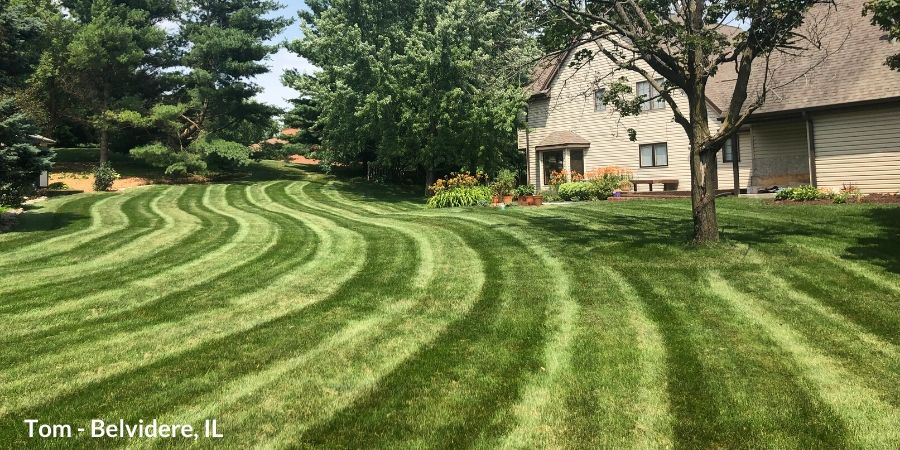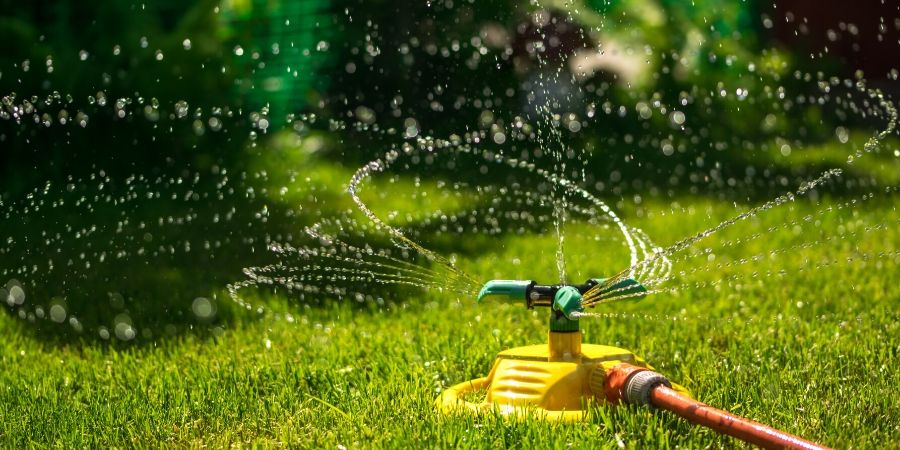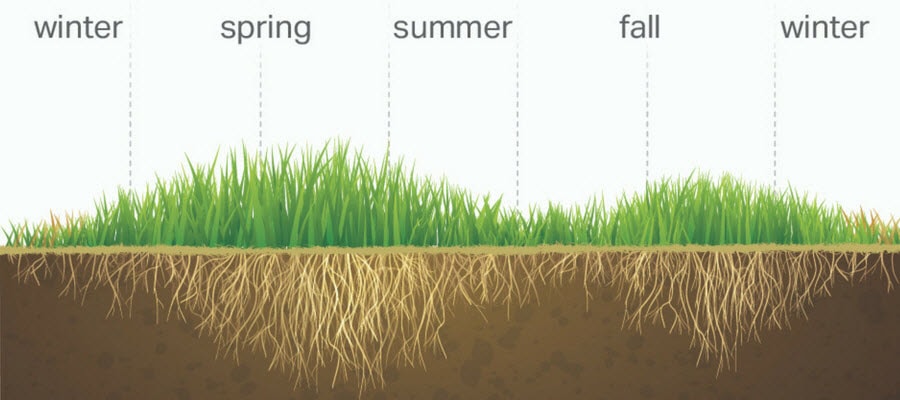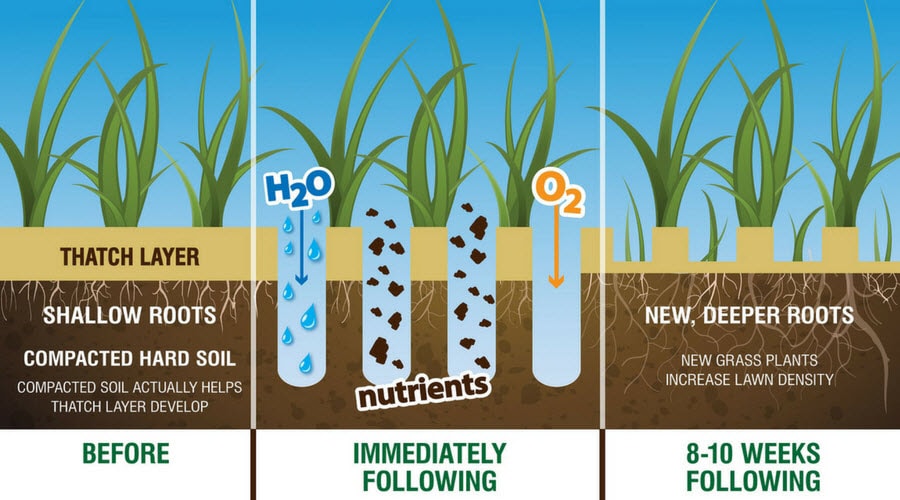Seasonal Maintenance of Cool-Season (Northern) Grasses
- Milorganite AgronomistApril 11, 2020
Here are tips for year-round lawn care in the North. These are the most important tasks for each season, including the best times of year to fertilize, dethatch, aerate and repair damaged lawns in the North.
Here’s your guide to maintaining your cool-season lawn throughout the year.
Cool-Season (Northern) Grass Varieties
Cool-season grass varieties you’ll find in the North include Kentucky Bluegrass (Common Kentucky Bluegrass), Annual Bluegrass, Rye grasses and Fescues. These varieties are able to withstand the freezing cold temperatures of the north and would roast in the heat of the South and West. You’ll also find these varieties in the transition zone, where cool-season and/or warm-season grasses will grow, depending on the local climate.

Summer (July–August): Northern Lawns Grass Care
Mow at the proper height for your grass variety.
Every grass variety has a preferred height. Adjust your mower blades set to the correct height. Taller grass helps to reduce weeds and promotes root growth. The grass is stronger and healthier when the roots are strong.
The taller and stronger the grass blade, the longer and healthier are the roots.
Free nutrients for your lawn.
Don’t throw away a source of free nutrients. Recycle grass clippings in place to give your lawn an extra boost of nitrogen.
By rain or hose, water to 1” weekly in the summer.
Lawns need a steady supply of water throughout the growing season. One inch of water weekly is all that’s needed to wet the top 6-8” of soil, whether it comes from nature or a spigot. If you’re watering, do it all at one time. The key is to water deeply and infrequently. Multiple light sprinkles of water don’t promote root growth and weaken the grass.
Irrigate or water early in the day to minimize evaporation and allow leaf blades to dry out.

If there is a drought in your area, it is okay to let your lawn go into drought-induced dormancy. Grasses have the ability to go dormant for differing lengths of time depending on their genetics and overall health.
Celebrate the Fourth of July by fertilizing.
Around the Fourth of July, plan on fertilizing with Milorganite at the recommended amount. Please follow with all community guidelines and restrictions for when and how much you can fertilize and water. Restrictions are created to help keep waterways clean and preserve natural resources.
Fall (September–November): Northern Lawns Grass Care
Fall is the most important time of year to tend to your lawn in the North, making it a task-filled season. Cool-weather offers the ideal growing conditions for cool-season grasses, which is why it’s the best time of year to fertilize. If you only have time to fertilize once a year, do it in fall while your lawn goes through another growth spurt and stores energy for winter. Good root growth in the fall results in better top growth in the spring.
Lawns eat and breathe, too.
Dethatching and aerating your lawn is best done while lawns are actively growing in the fall when the weather promotes a quick recovery.
Thatch is the layer of dead grass stems, roots and crowns that sit on top of the soil. If there’s more than 1/2", it’s time to dethatch. If too much thatch accumulates, water, nutrients, and air have a difficult time getting to the roots.
Aerate in the fall to loosen soil and promote grass growth.
Fall is also the best time of year to aerate your lawn in the North. We recommend using a core aerator, which removes plugs of soil and brings it to the surface. Once the cores dry out, rake to distribute the soil. The holes created by aeration loosens soil and provides a path for nutrients, water, and air to reach the roots. I recommend aerating every other year.
Overseed in the fall for a fuller, greener lawn in spring.
Overseeding is best done after dethatching and aerating when growing conditions are optimum. It’s time to overseed when daytime temperatures are consistently in the low- to mid-70s. Overseeding in fall gives the new grass time to establish before experiencing its first winter. Once you’re done overseeding, it’s a great time to top-dress your lawn with compost.
Hold off on applying a pre-emergent herbicide to rid your lawn of weeds as most cannot be applied for 6–8 weeks after seeding. Follow label directions carefully.
Fall fertilizer applications are most effective.
Fall is the best time of year to fertilize cool-season grasses—somewhere between early-September and Labor Day. If you only have time to fertilize once-a-year, now’s the time. Milorganite provides grass the nutrients it needs as it prepares for winter.
Around Thanksgiving, before the average first freeze or snowfall, it’s time for a dormant feeding with Milorganite. Nutrients will be available to your lawn in spring as it starts to grow because the nutrients are only released when the temperatures are at least in the 50s.
Continue watering in the fall.
As long as the grass is growing, continue to ensure your lawn gets 1” of water each week, whether it’s through rain, an irrigation system or a hose. Follow all community watering restrictions.
Continue mowing in the fall at the proper height, until the grass goes dormant.
Keep mowing your lawn at the correct height for your cool-season grass variety until it goes dormant. After the grass stops producing chlorophyll and goes dormant, cut all cool-season, northern grass varieties to 2”. The shorter grass blades are less likely to be matted down from snow, which can lead to a variety of lawn diseases, including snow mold.
Mulch leaves in the fall while mowing.
Mulch leaves using your lawnmower. Simply, mow over leaves until they’re reduced to the size of a dime. It may take a couple passes, but it’s less work then raking. Allow the mulched leaves to decompose in place, which adds organic matter to your lawn.
Winter (December–February): Northern Lawns Grass Care
Year-round lawn care in the North includes a winter break. Although there isn’t much to do, there are still a few things to pay attention to.
Heavy traffic on the lawn in winter can damage grass and compact soil.
Grass has an ingenious way of living through freezing temperatures. Ice crystals are formed between the cells, which protect them from damage. Walking on the lawn or moving heavy equipment over the lawn, causes the once helpful crystals to pierce the cells and may cause brown patches you’ll have to address in spring. Leaving heavy lawn equipment or vehicles over winter can kill the grass.
Get Your Lawn Mower Ready for Spring
Don’t wait until spring to maintain your lawnmower. Be prepared for when your lawn greens up again and to avoid the rush at hardware stores when everyone else is likely dropping off their mowers for maintenance. It’s particularly important to have sharp mower blades. Dull mower blades tear grass blades rather than giving them a nice, clean-cut. Ragged grass blades are more susceptible to diseases.
Spring (March-May): Northern Lawns Grass Care
Remove lingering piles of snow.
Even as the temperature begins to rise in spring, there are always those last remnants of winter—piles of snow that were so high or in the shade that is melting slowly. Snow and ice can be very damaging to the grass beneath. It blocks sunlight and doesn’t allow the grass to dry, which provides an ideal environment for diseases and molds to thrive.
Carefully shovel or rake the stubborn patches of snow to encourage melting.
Gently rake the lawn in early spring.
Reacquaint yourself with your entire lawn and give it a once-over. Lightly rake to remove winter debris that may have collected and to loosen matted grass. While you’re raking, survey the lawn for lawn diseases and pest damage, which may have occurred during the winter, and bare patches you’ll need to address before the weather gets too warm. You may also notice burrow holes from pests, such as moles and voles, or brown dead spots due to dog urine. Once it is warm enough, gently rake these areas and add topsoil and grass seed. Addressing the pest problem is now on your spring lawn-care task list.
It’s time to fertilize with Milorganite in late spring.
Remembering when to fertilize in the North and South is simple by remembering Milorganite’s holiday schedule. You’re going to fertilize around Memorial Day, the Fourth of July, Labor Day and Thanksgiving.
The first Milorganite application of the season should be between Memorial Day and mid-May.
The grass is most actively growing in spring, which you’ll notice on the Cool-season Grass Growth Cycle illustration below. Apply Milorganite after the danger of frost or a freeze has passed, and air temperatures are consistently in the 60s and soil temperatures are in the mid-50s.
Use the proper setting for your spreader. Consider applying fertilizer at half the recommended rate and walk in one direction. Apply the second half by waking in the opposite direction. This helps to ensure the entire lawn is covered. With a non-burning, slow-release nitrogen fertilizer, like Milorganite, you won’t have to worry about stripes of burned grass.
Cool-Season Grass Growth Cycle

Homeowners, start your mowers!
After the grass starts growing again, mow to the appropriate height for your variety of cool-season grass variety.
Spring lawn repair.
If you start noticing weeds in your lawn, April and May are great times to spot treat or hand-pull weeds.
If there are bare patches in your lawn, the first thing to do is identify the problem. Treating for the wrong problem with the wrong product won’t do your lawn or your wallet any good. Check out our Common Lawn Diseases to help you identify the culprit. If you’re having difficulty identifying the problem, contact your local extension.
After the problem has been addressed, patch the area by first gently raking and removing dead grass. Top dress the area with 1/2" of compost then apply grass seed that’s been mixed with Milorganite and gently rake it in. Apply your grass seed and Milorganite when your soil temperatures are in the mid-50s. You’ll know your soil is at the correct temperature when nighttime temperatures are consistently in the mid-50s. Or, feel free to check out your soil’s temperature using a soil temperature map. Milorganite is safe for tender grass shoots because it’s non-burning. Keep the patch consistently moist.


